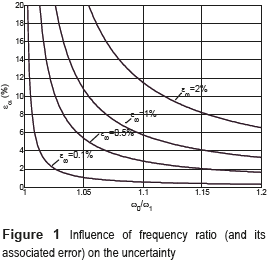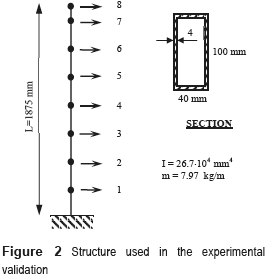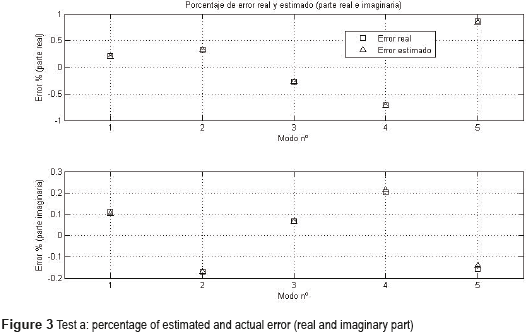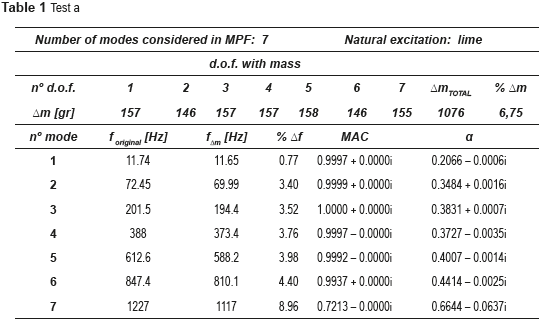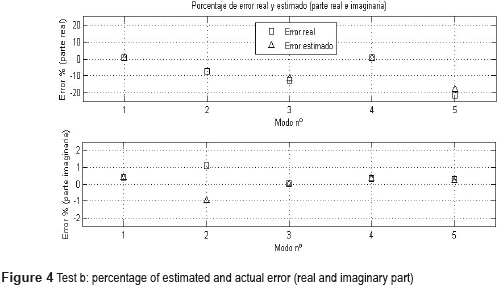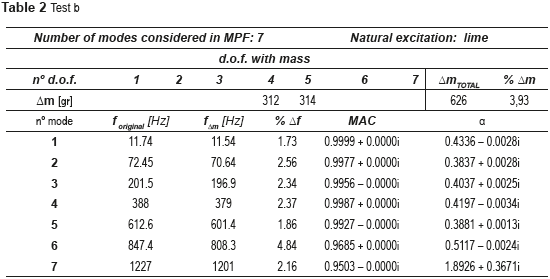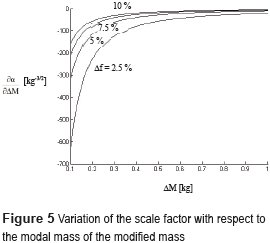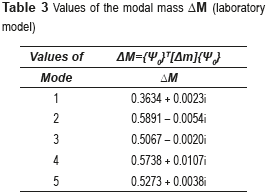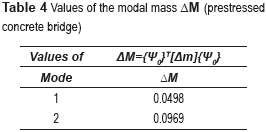Services on Demand
Journal
Article
Indicators
-
 Cited by SciELO
Cited by SciELO -
 Access statistics
Access statistics
Related links
-
 Cited by Google
Cited by Google -
 Similars in
SciELO
Similars in
SciELO -
 Similars in Google
Similars in Google
Share
Revista Facultad de Ingeniería Universidad de Antioquia
Print version ISSN 0120-6230
Rev.fac.ing.univ. Antioquia no.75 Medellín Apr./June 2015
https://doi.org/10.17533/udea.redin.n75a19
ARTÍCULO ORIGINAL
DOI: 10.17533/udea.redin.n75a19
Error analysis in obtaining scale factors with operational modal analysis and mass change
Análisis del error en la obtención de factores de escala con análisis modal operacional y cambio de masa
Luis Manuel Villa-García*
Departamento de Construcción e Ingeniería de Fabricación, Escuela Politécnica de Ingeniería de Gijón. Campus de Gijón, s/n, 33203. Gijón, España.
* Corresponding author: Luis Manuel Villa García, e-mail: villa@uniovi.es
DOI: 10.17533/udea.redin.n75a19
(Received May 08, 2014; accepted March 25, 2015)
Abstract
In operational modal analysis, the accuracy obtained in the identification of modal parameters, on the one hand, and the expertise in the modification of mass used to alter the dynamic behavior of the structure, on the other, decisively affect the accuracy achieved in the estimation of the scaling factors. Through experimental tests and numerical calculations, both the experimental validation of the estimate of the error in the scaling factor due to errors in the mode of vibration and the analysis of the influence of the modal mass in the variation of the scale factor, have been carried out. From all the above, it is concluded that it is necessary to pay special attention to how to make and modify inertial increments, i.e. changes in mass.
Keywords: operational modal analysis, scaling factors, sensitivity, mass-change method
Resumen
En el análisis modal operacional, por una parte, la exactitud obtenida en la identificación de los parámetros modales y, por otra, la pericia en la modificación de masa utilizada para alterar el comportamiento dinámico de la estructura, afectan de forma decisiva la exactitud alcanzada en la estimación de los factores de escala. Mediante ensayos experimentales y cálculo numérico, se ha realizado la validación experimental de la estimación del error en el factor de escala debido a errores en el modo de vibración, así como el análisis de la influencia de la masa modal en la variación del factor de escala. De todo ello se concluye que es necesario prestar especial atención a la forma de realizar y modificar los incrementos inerciales, es decir, la modificación de masa.
Palabras clave: análisis modal operacional, factores de escala, sensibilidad, método del cambio de masa
Introduction
The accuracy achieved in the estimation of the scaling factors is dependent on the identification of modal parameters [1-3] and the mass modification strategy used to alter the dynamic behavior of the structure [4-6]. The methodology for mass modification is based on the size, location and number of masses added to the structure.
It can be shown that to reduce the uncertainty in the estimation of the scaling factors, errors in the estimation of modal parameters [7, 8] must be minimized for the pilot phase of the modal analysis, as well as the difference between the modified and unmodified modes of vibration [9-11].
The difference between the original and the modified modes of vibration is minimized when:
A large number of masses is added to the structure.
The masses are adequately distributed.
The masses are located at optimum positions (peaks and valleys of the modes of vibration).
The magnitude of the change in mass is small.
Nevertheless, a minimal change is required in the magnitude of the mass [10, 11] in order to ensure minimum frequency deviation and avoid uncertainties in the identification of modal analysis [12, 13]. Moreover, the change of mass should not be too high in order to minimize the difference between the modified and unmodified modes of vibration.
In [9] showed that the presence of a relative error ε in the measured frequency deviation, induces a relative error of magnitude ε/2 in the normalization results obtained.
In [14], there is a first expression for the sensitivity of the scaling factors for errors produced during the evaluation of the magnitude of the frequency deviation in experimental tests. This is obtained (1) by differentiating the equation

with respect to the frequency ratio ηω=ω0/ω1, (2) resulting in

Also, in [14] demonstrated that a relative error εηω in the frequency ratio of a given mode of vibration, induces a relative error given by the expression (2) in the scale factor εα. However, it should be noted that this relationship between relative errors is applicable to the variation of frequency ratio with respect to itself  , and not to the difference between the relative errors (3) that correspond to the frequency before (ω0) and after (ω1) the change in mass (which is as shown in [14]), i.e.
, and not to the difference between the relative errors (3) that correspond to the frequency before (ω0) and after (ω1) the change in mass (which is as shown in [14]), i.e.

On the other hand, it can be easily seen that for low frequencies, the effect produced by the same absolute error becomes greater. A plot of equation (2) is represented [14] in Figure 1, where the significance, already known, of using an additional mass sufficient to achieve a reasonable frequency deviation [15], can be seen.
The sensitivity of the results of normalization (α scaling factors) produced by the error (4) on the operational mode of vibration {Ψ0} in the degree of freedom k (location of the mass Δmk), is given by [9].

The recognition of the above equation indicates that if several degrees of freedom belonging to an estimated mode of vibration, scaling considered, exhibit a similar relative error e, the resulting error in the normalization will be approximately equal to e.
In this paper, the theoretically deduced term above has been validated through experimental tests and numerical calculation in order to check whether the estimate of the error in the scaling factor due to errors in the vibration mode is acceptable. Moreover, the influence of the modal mass in the variation of the scale factor is studied.
Testing and operational modal analysis
The experiments were performed on a cantilevered bar, consisting of a 4 mm thick steel tube of 100 by 40 mm constant rectangular section, vertically arranged (Figure 2), with a height of 1875 mm, fixed in its base to a test frame using a four screw rectangular support plate.
To define the dynamic behavior of the structure, 8 degrees of freedom were established by obtaining measures through other many accelerometers, located and oriented as shown in Figure 2. The distance between degrees of freedom is 250 mm, except between points 7 and 8, where it is reduced to 125 mm. The point masses needed to modify the dynamic behavior of the structure were linked to the degrees of freedom 1 to 7.
Initially, some preliminary tests were performed in order to deduce the modal parameters of the structure, and later, in a second step, the mass-change method was applied, placing point masses at different degrees of freedom.
As a naturally random excitation source, contact with a file was used by applying light pressure, together with a longitudinal displacement on the outer surface of the tube so that the excitation was stationary in bandwidth. Responses were measured with 8 4508B Brüel & Kjær accelerometers, positioned as shown in Figure 2, and recorded with a data acquisition board (National Instruments PCI4472) controlled by Labview.
Throughout the investigation, only the first seven modes were recorded. The analysis of data extracted from the experimental tests was performed with the Artemis Extractor software, using the methods: Enhanced FREQUENCY DOMAIN DESCOMPOSITION Peak Picking and STOCHASTIC SUBSPACE IDENTIFICATION CVA Estimation.
Experimental validation of the estimate of the error in the scaling factor due to errors in the mode of vibration
Assuming that the main error in the modes of vibration occurs with the change of its components following the linking of masses to the degrees of freedom selected, then the actual error in the scale factors depending on whether the modes of vibration used are modified or unmodified, is calculated first, and then, the estimated error as a result of the use of the expression (4) given by [9].
From the multitude of tests conducted, the two shown below were selected (Figures 3 and 4, Tables 1 and 2), corresponding to those which, from this point on, will be referred to as tests a and b.
Then, the mass-change method was applied in order to calculate the scaling factors and modified modal parameters of the structure. The results obtained are shown in the tables cited above, where, for the first seven modes, the original frequencies and those obtained after the change in mass, as well as the percentage variance of the frequency, the MAC between the modified and unmodified modes, and the resulting scale factor (5) calculated using the following expression [11, 16], in which modified and unmodified modes of vibration are used, are all indicated.

In the first of these (test a), the weighted mass of the structure is around 7% of its value, and masses are added at all the degrees of freedom considered in the analysis. In the second one (test b), meanwhile, the linked mass is limited to approximately 4% and only two-point masses are added. In both tests, it is a question of optimizing the position of the linked masses for as many modes as degrees of freedom to which additional masses (7 d.o.f.) are fixed.
In the first case, with a uniform mass distribution along the structure, the errors are very small (always less than 1%), as shown in the graph, and there is a complete agreement between the actual and estimated errors, both for the real and imaginary parts, while in the second, because the results used in the expression (4) given by Parloo are not the most favorable, the magnitude of the errors is higher because an insufficient number of masses (only 2) is used simultaneously to optimize their position for a high number of modes.
In the second one (test b), as can be seen in the graph, it is not possible to give a reasonable estimate of the error for mode 2. For the remaining modes, the predicted error is satisfactory, which was intented to be verified to be verified. However, only acceptable errors for modes 1 and 4 are obtained, while errors for mode 3 oscillate in the range between 11 and 13%.
Influence of the modal mass in the variation of the scaling factor
The expression for determining the scale factor (6) can be written as

being ηω=ω0/ω1 the ratio of frequencies, and ΔM={Ψ0}T[Δm]{Ψ0} the modal mass of the mass modification matrix [Δm]. In this case (7), the partial derivative of the scale factor a indicated in Eq. (6) with respect to ΔM is

A graphical representation of the above expression is shown in Figure 5, where it can be seen that, as the modal mass and the frequency deviation increase, their influence on the scaling factor decreases, until the moment where it is no longer effective to add more mass to the structure, since the increase does not affect the scaling factor.
A change in mass of around 5% of the total mass (see [9, 11]) is generally a reasonable change in its magnitude.
Furthermore, in [17] suggest, based on their own experimental results, particularly as applied to bridges, that by just selecting changes in mass that reach frequency deviations of around 1% or 2%, good results are obtained.
Nevertheless when interpreting the chart above, the additional disadvantage is that the magnitudes involved are not dimensionless arises. Thus, in the case of the modal mass ΔM={Ψ0}T[Δm]{Ψ0} (corresponding to the mass modification matrix ([Δm]), the range of values which contain the real cases must be known in order to limit our search area in the graph.
For example, for the structure tested in the laboratory (Figure 2), the values of ΔM={Ψ0}T[Δm]{Ψ0} obtained for the first five modes are shown in Table 3, while in the case of a real structure, consisting of a section of a pre-stressed concrete bridge with a span of 25.5 m, the values obtained for the first two modes are reflected in Table 4.
In addition, again using expressions (6) and (7), the following (8) and (9), is easily reached:

i.e.

From this, it follows that a relative error in the modal mass induces in the scaling factor a relative error of double magnitude and opposite direction.
Conclusions
With respect to the experimental validation of the error estimation in the scaling factor due to errors in the mode of vibration, it is concluded that it is only possible to carry out error estimates valid in determining the scale factor if special attention is given to how to make and modify the inertial increments, specifically as regards:
The proportion of the total mass and its distribution upon the structure.
The use of a number of masses (at their corresponding degrees of freedom) sufficient to fit the number of modes of interest.
With respect to the variation of the scaling factor with regard to the modal mass of the mass change, it follows:
From the graphical representation of the expression (7), shown in Figure 5, that as the modal mass and frequency deviation increase, their influence in the scaling factor is reduced, until a time comes when it is no longer effective to add more mass to the structure, since the increase does not affect the scaling factor.
From expression (9), that a relative error in the modal mass induces in the scaling factor a relative error of double magnitude and opposite direction.
References
1. G. Coppotelli. ''On the estimate of the FRFs from operational data''. Mechanical Systems and Signal Processing. Vol. 23. 2009. pp. 288-299. [ Links ]
2. O. Cakar, K. Sanliturk. ''Elimination of transducer mass loading effects from frequency response functions''. Mechanical Systems and Signal Processing. Vol. 19. 2005. pp. 87-104. [ Links ]
3. Y. Zhang, Z. Zhang, X. Xu, H. Hua. ''Modal parameter identification using response data only''. Journal of Sound and Vibration. Vol. 282. 2005. pp. 367-380. [ Links ]
4. D. Bernal. ''Modal Scaling from Known Mass Perturbations''. Journal of Engineering Mechanics. Vol. 130. 2004. pp. 1083-1088. [ Links ]
5. W. D'Ambrogio, A. Sestieri, ''Coupling theoretical data and translational FRFs to perform distributed structural modification''. Mechanical Systems and Signal Processing. Vol. 15. 2001. pp. 157-172. [ Links ]
6. H. Hang, K. Shankar, J. Lai. ''Effects of distributed structural dynamic modification with reduced degrees of freedom''. Mechanical Systems and Signal Processing. Vol. 23. 2009. pp. 2154-2177. [ Links ]
7. S. Braun, Y. Ram. ''Modal modification of vibrating systems: some problems and their solutions''. Mechanical Systems and Signal Processing. Vol. 15. 2001. pp. 101-119. [ Links ]
8. J. Mottershead, C. Mares, S. James. ''Fictitious modifications for the separation of close modes''. Mechanical Systems and Signal Processing. Vol. 16. 2002. pp. 741-755. [ Links ]
9. E. Parloo, P. Verboven, P. Guillaume, M. Overmeire. ''Sensitivity-based operational mode shape normalization''. Mechanical Systems and Signal Processing. Vol. 16. 2002. pp. 757-767. [ Links ]
10. R. Brincker, P. Andersen. A Way of Getting Scaled Mode Shapes in Output Only Modal Analysis. Proceedings of the 21st International Modal Analysis Conference (IMAC XXI). Kissimmee, USA. 2003. pp 141-145. [ Links ]
11. M. López, R. Brincker, A. Fernández, L. Villa. Scaling Factor Estimation by Mass Change Method. Proceedings of the 1st International Operational Modal Analysis Conference (IOMAC). Copenhagen, Denmark. 2005. pp. 53-64. [ Links ]
12. K. Yap, D. Zimmerman. ''A comparative study of structural dynamic modification and sensitivity method approximation''. Mechanical Systems and Signal Processing. Vol. 16. 2002. pp. 585-597. [ Links ]
13. M. Khatibi, M. Ashory, A. Malekjafarian, R. Brincker. ''Mass–stiffness change method for scaling of operational mode shapes''. Mechanical Systems and Signal Processing. Vol. 26. 2012. pp. 34-59. [ Links ]
14. M. López, P. Fernández, R. Brincker, A. Fernández. Scaling Factor Estimation Using An Optimized Mass Change Strategy. Part 1: Experimental Results. Proceedings of the 2nd International Operational Modal Analysis Conference (IOMAC). Copenhagen, Denmark. 2007. pp. 21-28. [ Links ]
15. H. Hang, K. Shankar, J. Lai. ''Prediction of the effects on dynamic response due to distributed structural modification with additional degrees of freedom''. Mechanical Systems and Signal Processing. Vol. 22. 2008. pp. 1809-1825. [ Links ]
16. L. M. Villa G. ''Análisis de sensibilidad aplicado a la dinámica de estructuras mediante la modificación de las propiedades inerciales''.Rev. Fac. Ing. Univ. de Ant. N.º 70. 2014. pp. 66-74. [ Links ]
17. E. Parloo, B. Cauberghe, F. Benedettini, R. Alaggio, P. Guillaume. ''Sensitivity-based Operational Mode Shape Normalisation: Application to a Bridge''. Mechanical Systems and Signal Processing. Vol. 19. 2005. pp. 43-55. [ Links ]













